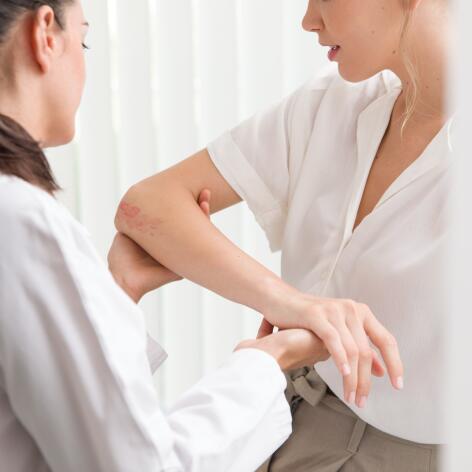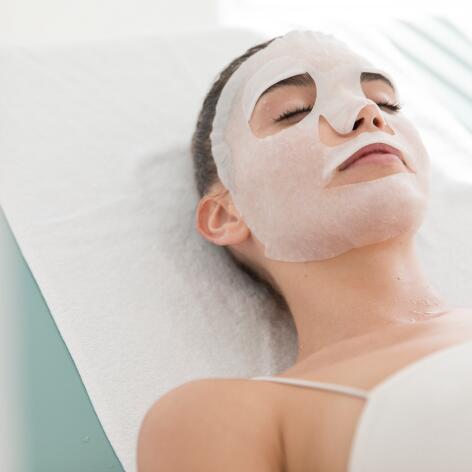Eczema: what treatments?
- Living with eczema and psoriasis
- Living with eczema and psoriasis: Children
- Psoriasis and eczema for children - rules for moisturizing
- Psoriasis and eczema in adults: suitable hygiene
- Adults - Care and anti-itching tips
- Children - Care and anti-itching tips
- Psoriasis and eczema in children: suitable hygiene
- Living with eczema and psoriasis: Adult
- Psoriasis and adult eczema - rules for moisturizing
Eczema: what treatments?
While they cannot yet be cured, atopic eczema and contact eczema, also called allergic eczema, can be treated. For the latter, the main measure is to avoid the allergenic element. And in both cases, there's nothing like a good daily moisturiser with an emollient to protect the skin and soothe the itching.

Eczema: moisturise before anything else
With good daily habits, it’s possible to prevent and reduce the symptoms of eczema. How? Moisturise your skin every day, even if you don’t have any skin lesions. In the case of contact eczema, protecting your skin gently and continuously limits the inflammation caused by exposure to allergens. Your skin barrier is strengthened and irritating substances can no longer weaken your skin. You can say goodbye to itching! Maintaining hydration also reduces water loss and intercellular lipid deficiencies, which are very common in atopic eczema: skin dryness is reduced and flare-ups are spaced out.
FRIENDLY (AND EXPERT) ADVICE
It’s advisable to apply the moisturizing emollient after showering and drying off: your skin will still be slightly softened by the moisture and the balm will glide more easily over the skin.
Eczema: therapeutic solutions
During flare-ups of atopic eczema and contact eczema, your dermatologist may prescribe:
- Corticosteroid creams to soothe the redness and itching.
- Antibiotics if there is a bacterial or fungal infection on a plaque.
- Copper and zinc creams to restore and cleanse fragilized skin (Avène Cicalfate).
For atopic eczema, you may also be prescribed:
- Antihistamines to prevent scratching. By reducing itching sensations, they improve the quality of sleep.
- Immunomodulating drugs (acting on the immune system) without steroids reduce inflammation. These solutions are not prescribed before the age of 2.

Eczema, the right product in the right quantity!
Taking care of your skin or your child's skin requires appropriate daily moisturizing:
1. One season, different solutions
In the summer, opt for creams and lotions: their fluid texture penetrates the skin easily. More nourishing balms will be your best moisturizing friends to get through the winter. During this season, the cold dries out the skin more, as does indoor heating.
2) Apply a sufficient amount of cream
Start with very thin layers for soft and silky smooth skin. It feels much better than thicker layers. And you can add more gradually if needed: much easier than having to remove excess cream!
FRIENDLY (AND EXPERT) ADVICE
To enjoy all the benefits of the emollient!
Daily moisturizing provides relief, reduces medication use and anxiety related to eczema.
Ideally, an emollient should be applied at least twice a day. Trust yourself: you know your skin and know when it needs to be moisturised. The key with atopic eczema is to be regular in these gentle rituals, to reduce the frequency and use of treatments. In addition to deeply moisturizing your skin, emollients reduce the need for dermocorticoids. Finally, the level of stress generated by the apprehension of a flare-up, and sometimes even social embarrassment, is reduced.

Tips & tricks for your daily peace of mind!
To protect yourself as much as possible from eczema:
- Avoid exposure to skin irritants (chemicals, washing liquids, wools, etc.) and extreme temperatures to prevent itching.
- Apply cold compresses or Avène Thermal Spring Water to soothe the inflammation and reduce the desire to scratch.
- In the shower, use cleansing gels or creams, syndets or dermatological lotions.
- Apply an emollient daily to limit and prevent dry skin.
Our solutions to hydrate your atopic-prone skin
Eau Thermale Avène products designed to relieve your atopic eczema:
- Avène Thermal Spring Water Spray
Best Seller
Thermal Spring Water
Avène Thermal Spring Water SpraySoothes - Restores the skin barrier - Calms - XERACALM A.D Lipid-replenishing cream
XeraCalm
XERACALM A.D Lipid-replenishing creamNourishes - Soothes - Hydrates - Soothes itchiness*
Which skin care routine should you adopt?
Identify what it really needs with the help of our experts and discover the most suitable skin care routine for you.



